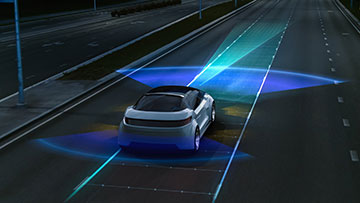
Artist's rendering of a futuristic self-driving car. [Image: gorodenkoff / Getty Images]
Companies are pursuing multiple different paths—lidar, radar, camera-based systems—toward the goal of reliable sensing systems for autonomous vehicles. A recent, interesting twist illustrates how uncertain the road remains.
On 9 September, the Israel-based automated-driving technology firm Mobileye announced plans to discontinue its internal development of frequency-modulated continuous-wave (FMCW) lidar, concluding that the technology had become “less essential” to its plans to address the autonomy market. Then, just a day later, the US silicon photonics startup SiLC Technologies announced an investment from Japanese multinational auto manufacturer Honda Motor Co. to continue SiLC’s next-generation development of the same FMCW lidar technology.
Sensing position and velocity
In principle, FMCW lidar, a coherent detection method, has the capability to both locate objects and determine their velocity. Low-power, frequency-chirped laser light at 1550 nm, reflected off of an object, gives the distance of the measurement point as a frequency shift, determined interferometrically; further, any radial velocity can be teased out in a Doppler frequency shift. Thus range and velocity are resolved for each pixel.
The photonic circuitry of FMCW lidar mixes a portion of the outgoing laser light with the received light, providing what SiLC refers to as a “unique unlock key”—each sensor is designed to respond only to its own light, blocking background radiation like ambient light and interference from other lidar systems (like those that could be in nearby vehicles).
The coherent mixing of the local oscillator and the received signal provides an amplified peak frequency through constructive interference before it’s picked up by a photodetector. The range and velocity are then extracted via a Fourier transform on the received waveform.
Mobileye says goodbye
Mobileye said in a press release that it will wind down its FMCW lidar development unit, which has cost the Intel-majority-owned firm nearly US$60 million in fiscal 2024, by the end of this year. The company said that this decision was “part of our regular review of the long-term technology roadmap,” and that it “now believe[s] that the availability of next-generation FMCW lidar is less essential to our roadmap for eyes-off systems.”
The company has taken a dual approach to autonomous driving, which the Israel-based firm calls “true redundancy.” The approach includes both a camera-based system and a radar- and lidar-based system, with each generating its own independent viewing stream. With the end of its R&D into FMCW lidar, the company seems to be focusing on computer vision, radar and time-of-flight lidar units, citing “substantial progress on our EyeQ6-based computer-vision perception, increased clarity on the performance of our internally developed imaging radar and continued better-than-expected cost reductions in third-party time-of-flight lidar units,” as factors.
Mobileye said in a press release that it will wind down its FMCW lidar development unit, which has cost the Intel-majority-owned firm nearly US$60 million in fiscal 2024, by the end of this year.
While the closure is expected to affect about 100 employees, the company added that it “does not impact any of our customer product programs or product development in general.” The firm also stressed that the move has “no bearing” on Mobileye’s in-house imaging radar arm, which it says is meeting specs and “expected to enter production next year, on schedule.” Mobileye said in a separate press release in April 2024 that the latest version of its automotive system-on-chip, EyeQ6 Lite, is scheduled to be installed in 46 million cars over the next few years.
The announcement comes during a tumultuous year for Mobileye, which has seen record-low share prices as automakers have cut production due to excess inventory. In August, the company lowered its full-year earnings guidance because of “a more significant than anticipated softening of business conditions in China,” according to President and CEO Amnon Shashua. Stock prices rebounded nearly 15% on 19 September, after Intel said in a press release that it currently had no intention of selling its stake in Mobileye.
Honda funds SiLC
In contrast to Mobileye’s jaded view of FMCW lidar, California-based SiLC is apparently still bullish. The firm announced on 10 September that Honda is investing an undisclosed sum in SiLC’s development of next-gen FMCW lidar, through the automaker’s Honda Xcelerator Ventures program for “open innovation and corporate venturing” for global startups.
In a press release, Manabu Ozawa, Honda’s Managing Executive Officer, expressed confidence in both SiLC and the technology. “SiLC is the industry leader in the research and development of FMCW lidar, which is capable of detecting vehicles and various obstacles from long distances.” Ozawa said. “And Honda has high expectations for its potential.” He added that Honda hopes the SiLC technology will prove important toward the automaker’s goal of “zero traffic collision fatalities involving our motorcycles and automobiles globally by 2050.”
SiLC claims that FMCW lidar is “the ideal platform” for safe autonomous driving, noting that it can detect dark objects, distinguish between slow-moving and stationary vehicles, and overcome interference.
SiLC claims that FMCW lidar is “the ideal platform” for safe autonomous driving, noting that it can detect dark objects, distinguish between slow-moving and stationary vehicles, and overcome interference. It introduced four versions of its FMCW-based Eyeonic Vision System in October 2023, covering short to ultra-long ranges.
“Our silicon photonics platform offers a powerful, low-cost, efficient and scalable FMCW lidar engine, which is essential for the high volumes required by the automotive industry,” said SiLC CEO Mehdi Asghari. “SiLC’s FMCW LiDAR solutions bring superior vision to machines to truly enable the next generation of AI-based automation and move us closer to a more intelligent, interconnected future.”
